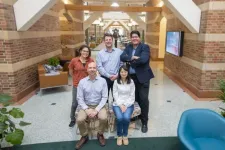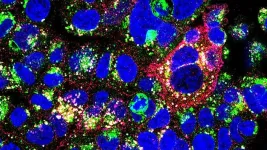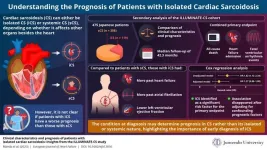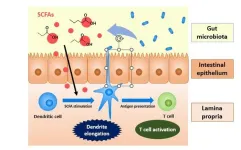(Press-News.org) WASHINGTON – The Society for Neuroscience (SfN) will honor eight early-career researchers whose work is transforming our understanding of the neural dynamics of touch sensation, spatial navigation, memory circuits, and more. The awards will be presented during Neuroscience 2023, SfN's annual meeting. “This year’s Early Career Awardees are pushing the boundaries of neuroscience by combining cutting-edge methods in machine learning, microscopy, genetics, biophysics, and beyond,” said SfN President Oswald Steward. “These multi-disciplinary approaches will define neuroscience in the coming years, and it is exciting to see our next generation of research leading the way,” Steward said.
Jennifer N. Bourne Prize in Brain Ultrastructure: Yusuke Hirabayashi
The Jennifer N. Bourne Prize in Brain Ultrastructure recognizes early career neuroscientists for outstanding work that advances our understanding of brain structure and function at the nanometer scale. Named for Jennifer N. Bourne, an electron microscopist and core facility director who studied the structural plasticity of synapses, the award honors brain ultrastructure researchers who are within their first five years of academic appointments. The award is funded by Kristen M. Harris and includes a $5,000 prize and travel to SfN’s annual meeting.
This year’s recipient of the Bourne Prize is Yusuke Hirabayashi, an associate professor at the University of Tokyo and a rising leader in the field of ultrastructure imagery. Among many achievements, Hirabayashi developed specialized microscopy techniques to make important discoveries regarding how neuronal organelles interact to regulate calcium dynamics. By combining cutting-edge microscopy methods with genetic engineering and biochemistry, Hirabayashi identified the nanometer-scale points of contacts between mitochondria and the endoplasmic reticulum and the two work together to regulate neuronal calcium dynamics; while both organelles were previously known to regulate intracellular levels of calcium, their interaction was unclear due to their complex structures. Hirabayashi also developed Correlated Light-Serial Scanning Electron Microscopy (CoLSSEM) to create 3D reconstructions of genetically labeled single neurons. Recognizing the need to add automation to the time-consuming process that led to this discovery, Hirabayashi subsequently developed a “biologist-friendly” computational method for efficient, large-scale visualization and quantification of organelle structures. This tool is publicly accessible via GitHub and has been downloaded more than
35,000 times, demonstrating the intense growing interest in organelle interfaces across the biological sciences.
Donald B. Lindsley Prize in Behavioral Neuroscience: Patrick LaChance
Endowed by The Grass Foundation, the Donald B. Lindsley Prize in Behavioral Neuroscience recognizes an outstanding PhD thesis in the area of general behavioral neuroscience. The award was established in 1979 in honor of Donald B. Lindsley, an early trustee of the Grass Foundation. The award includes a $5,000 prize and travel to the SfN annual meeting. This year’s recipient of the Lindsey Prize is Patrick LaChance, for his PhD thesis investigating how animals understand their position and movement in the context of their surroundings. Animals use both internal and external information to develop a sense of their body’s positioning and orientation to help them navigate through the world. Most research on spatial processing in the rodent brain has focused on the external cues encoded by place cells in the hippocampus and grid cells in the entorhinal cortex, which together allow an individual to create a mental map and place themselves in it. As a PhD student at Dartmouth College, LaChance took a different approach to spatial processing by recording from a different part of the rodent brain called the postrhinal cortex, which correlates to the parahippocampal cortex in humans. In his experiments, a rat explored a simple box environment while implanted electrodes recorded the neuronal activity of the postrhinal cortex and the animal’s location and head position were simultaneously tracked by an overhead camera. The data was then analyzed using a statistical method developed by LaChance that revealed neuronal activity related to internal cues as opposed to external cues. Through these experiments, LaChance identified three populations of cells in the postrhinal cortex that encode different types of internal and external cues about spatial positioning within the environment. The work resulted in a first author paper in Science, the first of several first-author papers produced by LaChance as a graduate student. In further experiments involving novel objects or other experimental changes, LaChance showed how contextual cues in the environment influence patterns of neuron firing in the postrhinal cortex. Collectively, LaChance’s PhD work provides key insights into how contextual information about an animal’s surroundings is processed, including how visual landmarks are integrated into a framework that supports the neural encoding of landmark-based orientation. LaChance completed his PhD in 2022 and is now a postdoctoral associate at Boston University.
Nemko Prize in Cellular or Molecular Neuroscience: Gily Ginosar
The Nemko Prize in Cellular or Molecular Neuroscience, supported by The Nemko Family, recognizes a young neuroscientist's outstanding PhD thesis advancing our understanding of molecular, genetic, or cellular mechanisms underlying higher brain function and cognition. The award includes a $2,500 prize and travel to the SfN annual meeting.
This year’s Nemko Prize recipient is Gily Ginosar, for her groundbreaking research on the neuronal basis of three-dimensional navigation. As a PhD student at the Weizmann Institute of Science in Israel, she trained fruit bats to fly in a large room, while she wirelessly recorded the firing of single neurons in the entorhinal cortex. It was previously noted that grid cells, which are key to creating a coordinate map, form a hexagonal lattice, but Ginosar’s research did not find the three-dimensional lattice that is key to most existing models. Instead, her research suggests that the key feature of grid cells is a characteristic distance between neighboring firing-fields, which leads to a hexagonal lattice in two dimensions, but not in three dimensions. Ginosar’s research also discovered the border cells used in three-dimensional navigation, which can take either two-dimensional or one-dimensional forms. Together, this information on grid and border cells outlines their functions in animals that navigate freely in three-dimensional space. More importantly, Ginosar’s results call into question leading theories for the function of grid cells in three-dimensional space, as the lattice pattern is a key requirement in most existing models.
Ginosar has also broadened her work in three-dimensional navigation by examining the perception of three-dimensional space by Air Force fighter pilots compared to non-pilots in an advanced flight simulator. While the pilots perceived less distortion of the z-axis of their self-motion as compared to the control group, they showed similar errors when assessing their surrounding space. This suggests two different mechanisms are involved in processing three-dimensional space in humans: a plastic perception of traveled space and a rigid perception of surrounding space.
Peter and Patricia Gruber International Research Award: Emilia Favuzzi, Tristan Geiller, and Abhilasha Joshi
The Peter and Patricia Gruber International Research Award in Neuroscience recognizes up to three young neuroscientists for outstanding research and educational pursuit in an international setting. The award is supported by The Gruber Foundation and includes a $25,000 prize and travel to the SfN annual meeting.
Emilia Favuzzi, an assistant professor at Yale, has made profound discoveries about brain wiring during her international scientific career. Recently, Favuzzi has uncovered that microglia, the main brain immune cells, selectively communicate with specific neuronal types. Disrupting these selective interactions causes wiring defects and behavioral abnormalities, indicating that brain function relies on neuroimmune and neuron-glia interactions that may be as specific as those between neurons.
Tristan Geiller’s work in manipulating neurons in vivo has helped illuminate the precise interactions and anatomy needed for memory formation. Originally from France, Tristan gained his first international experience in Australia before working in industry in Korea, only to start his PhD at Korea University several years later. As a postdoctoral researcher at Columbia University, Geiller developed a technique that allowed him to genetically identify specific neurons in the hippocampus and control and record their activity in awake, behaving mice. This innovation and others have enabled Geiller to gain insights into local neural networks that underlie memory consolidation. Geiller is currently an associate research scientist at the Zuckerman Mind Brain Behavior Institute at Columbia University and will continue his work as an assistant professor at Yale University in January 2024.
Abhilasha Joshi, currently a Visiting Researcher at The Champalimaud Centre for the Unknown, Lisbon, Portugal, has researched the ties between locomotion and memory in rodents. Originally from India, Joshi conducted her graduate research at the University of Oxford in England, where she identified specialized groups of neurons that change their firing pattern in distinct ways when rodents switch between resting and running. Joshi then pursued her interest in the relationship between cognition and movement processing in the brain as a postdoctoral fellow at the University of California San Francisco. In her research, she found that stepping and spatial representation in the rat hippocampus were synchronized when performing a task that required recalling previous information, but not when performing routine actions. Cognitive and motor deficits often present together in diseases such as Alzheimer’s, and her research suggests these disparate symptoms might actually be linked.
Young Investigator Award: Ishmail Abdus‐Saboor and Marco Capogrosso
The Young Investigator Award recognizes the outstanding achievements and contributions by young neuroscientists who lead independent research groups. The award is supported by Sumitomo Pharma America, Inc. and includes a $15,000 prize and travel to the SfN annual meeting.
Ishmail Abdus-Saboor, a principal investigator at Columbia University’s Zuckerman Institute and an associate professor of biological science, seeks to understand the biological basis of tactile sensations, both to develop ways of measuring pain and pleasure objectively and to one day provide better care to those suffering with chronic pain. As a postdoctoral fellow, Abdus-Saboor began to tackle this challenge by developing a ground-breaking method for quantifying pain responses in mice. He used high-speed video cameras and machine learning to track and score sub-second pain-related changes in behavior, which enabled him to create a precise and reliable pain scale for mice. Abdus-Saboor also developed a method based in peripheral optogenetics that can activate pain in different regions of the body in mice with light, and through this he was able to show that pain receptors in non-hairy skin have a lower activation threshold than the same neurons in hairy leg skin. Abdus-Saboor’s lab also investigates pleasurable sensation and its importance in social interactions; recent studies identified specific neurons in the skin underlying pleasurable touch through activation of reward centers in the brain and they identified a critical role for these touch-responsive neurons in stress resilience in mice. The Abdus-Saboor lab has been generously supported by both federal and private foundations, allowing the lab to continue their current research efforts while also expanding to investigate somatosensation in naked mole rats.
The research of Marco Capogrosso has already impacted the lives of people with spinal cord injury. While researchers have long been interested in the use of implanted devices to electrically stimulate the spinal cord, the benefits have been variable. Since his graduate studies, Capogrosso has pursued a better understanding of electrical stimulation treatments, developing computational models that outline the mechanistic principles by which electrical fields interact with the spinal cord to enable the recovery of voluntary motor control. His conceptual framework has resulted in practical information such as the best places to apply electrodes on patients to maximize short and long-term recovery. Today, his model guides the design of stimulation strategies in clinical trials in this field around the globe. As an assistant professor at the University of Pittsburgh, he led a first-in-human clinical trial for electrical stimulation in the upper spinal cord to treat patients with upper body paralysis caused by stroke. Capogrosso is now director of the Spinal Cord Stimulation Laboratory at the University of Pittsburgh and member of the Rehab and Neural Engineering Labs and was recently awarded an $8 million grant from the NIH to further develop this treatment.
###
The Society for Neuroscience (SfN) is an organization of nearly 35,000 basic scientists and clinicians who study the brain and the nervous system.
END
Society for Neuroscience 2023 Early Career Scientists’ Achievements and Research Awards
2023-10-30
ELSE PRESS RELEASES FROM THIS DATE:
Society for Neuroscience 2023 Education and Outreach Awards
2023-10-30
WASHINGTON – The Society for Neuroscience (SfN) will present five neuroscientists with this year’s Science Education and Outreach Awards, comprising the Award for Education in Neuroscience, the Science Educator Award, and the Next Generation Awards. The awards will be presented during SfN’s annual meeting, Neuroscience 2023.
“The Society is honored to recognize this creative group of neuroscientists working to educate the public about science and combat misinformation,” SfN President Oswald Steward, said. “Their innovative approaches — including games and viral social media videos — inspire not just the next generation of neuroscientists, ...
A sustainable alternative to air conditioning
2023-10-30
As the planet gets hotter, the need for cool living environments is becoming more urgent. But air conditioning is a major contributor to global warming since units use potent greenhouse gases and lots of energy.
Now, researchers from McGill University, UCLA and Princeton have found in a new study an inexpensive, sustainable alternative to mechanical cooling with refrigerants in hot and arid climates, and a way to mitigate dangerous heat waves during electricity blackouts.
The researchers set out to answer how to achieve a new benchmark in passive cooling inside naturally conditioned buildings in hot climates such as Southern California. They examined the use of roof materials ...
Microdroplets, macro results: Beckman researchers pursue Energy Earthshots
2023-10-30
Good things come in microscopic packages, according to the Beckman Institute for Advanced Science and Technology’s new DROPLETS project.
By packaging electrochemical reactions in smaller-than-standard serving sizes, interdisciplinary researchers aim to produce clean hydrogen, sequester carbon dioxide, and store renewable energies like wind and solar inexpensively and sustainably. Their project, called DROPLETS, received $4.5 million from the U.S. Department of Energy’s Office of Science through its Energy Earthshots Initiative.
“If we do this right, we will ...
Landmark menopause toolkit updated to improve assessment and treatment
2023-10-30
Care for women with menopausal health issues should improve globally following the release of an updated Monash University-led toolkit that guides health professionals around the world in assessing and treating them.
Endorsed by the International, Australasian and British Menopause Societies, the Endocrine Society of Australia and Jean Hailes for Women’s Health, the 2023 Practitioner’s Toolkit for Managing the Menopause is designed to be used anywhere in the world.
Published in Climacteric, the Toolkit has been updated and enhanced from the original 2014 Toolkit for practitioners with new advice and therapies based on a systematic review of the latest menopause ...
New antibody could target breast cancers
2023-10-30
An enzyme that may help some breast cancers spread can be stopped with an antibody created in the lab of Cold Spring Harbor Laboratory Professor Nicholas Tonks. With further development, the antibody might offer an effective drug treatment for those same breast cancers.
The new antibody targets an enzyme called PTPRD that is overabundant in some breast cancers. PTPRD belongs to a family of molecules known as protein tyrosine phosphatases (PTPs), which help regulate many cellular processes. They do this by working in concert with enzymes called kinases to control how other proteins ...
Drawing a tube of blood could assess ALS risk from environmental toxin exposure
2023-10-30
Over the last decade, research at Michigan Medicine has shown how exposure to toxins in the environment, such as pesticides and carcinogenic PCBs, affect the risk of developing and dying from amyotrophic lateral sclerosis.
Now, investigators have developed an environmental risk score that assesses a person’s risk for developing ALS, as well as for survival after diagnosis, using a blood sample.
The results are published in the Journal of Neurology, Neurosurgery and Psychiatry.
“For the first time, we have a means collecting ...
Research grants available: $50,000 to evaluate race in risk calculators
2023-10-30
DALLAS, October 30, 2023 — Multiple 1-year grants of up to $50,000 each are available from the American Heart Association to fund research that evaluates the use of race in heart disease and stroke risk calculators.
The American Heart Association, the single largest non-government supporter of heart and brain health research in the U.S., is offering the funding as part of the De-Biasing Clinical Care Algorithms project. The project is a two-year scientific research strategy, supported in part by a grant from the Doris Duke Foundation, to study the complex issue of how race and ethnicity factor into clinical care ...
Shedding light on the paradoxical prognosis for patients with cardiac sarcoidosis, a rare and difficult-to-diagnose inflammatory heart condition
2023-10-30
Sarcoidosis is a complex inflammatory disease that causes the harmful accumulation of tiny clumps of cells called granulomas in the body. In most cases, sarcoidosis manifests in the lungs and lymph nodes. However, in approximately 10% of patients, the heart is affected; this condition is known as ‘cardiac sarcoidosis (CS).’ Although relatively rare, CS can cause life-threatening complications, including arrhythmia, heart failure, or sudden cardiac death.
One puzzling aspect of CS is that the condition sometimes involves the heart alone, without manifesting clinically apparent symptoms in other organs. This is referred to as isolated ...
Intestinal bacteria metabolite promotes capture of antigens by dendritic cells
2023-10-30
Dendritic cells play a key role in the mammalian immune system. These cells are present throughout the human body and are known to capture foreign bodies, i.e., antigens, using extendable “arms” called dendrites. Once captured, dendritic cells present these substances to immune T cells, thereby initiating an immune response. Dendritic cells are responsive to their environment and capable of changing their morphology and other attributes dynamically. For instance, dendritic cells in the intestine’s mucosa (inner layer) capture harmful bacteria by extending their dendrites through the epithelium (outermost layer) ...
Virtual meetings tire people because we're doing them wrong
2023-10-30
New research suggests sleepiness during virtual meetings is caused by mental underload and boredom. Earlier studies suggested that fatigue from virtual meetings stems from mental overload, but new research from Aalto University shows that sleepiness during virtual meetings might actually be a result of mental underload and boredom.
‘I expected to find that people get stressed in remote meetings. But the result was the opposite – especially those who were not engaged in their work quickly became ...



